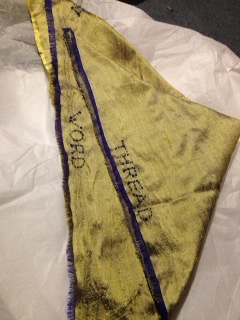Precario
Developing an artist led walk from the Dundas Gallery to the Royal Botanical Gardens in Edinburgh in July.
I have now started the process of preparing for a walk in Edinburgh using the poem by Cecilia Vicuña Thread and Word.This walk will be part of the exhibition of “Threads” at the Dundas Gallery in July which has been curated by the Artists Pool.
The walk will develop from #ThreadandWord which took place from Espacio Gallery to Leadenhall Market on March 5th. Details of the development of this walk can be found on this blog and also on my website.
As I was developing the walk in Shoreditch I was not aware that the exhibition would be travelling to Edinburgh. When I was contacted by Renee, curator at the Artists Pool about the possibility of the exhibition continuing in Edinburgh in July,
I was elated as it is the location where Cecilia Vicuña wrote her poem ‘Hilo y Palabra’ (Thread and Word) in 1997. It was published as a limited edition print as a part of an installation at Inverleith House in the Botanical Gardens.
I have copied the archive describing Cecilia Vicuña’s practice below.
I am starting to research the walk with a trip to Edinburgh next Tuesday, where my plan is to visit the Dundas gallery and then walk to the Royal Botanical Gardens. Cecilia Vicuña’s installation was titled ‘Precarious'(Precario).
I think PRECARIO is a good working title for this walk as it expresses the fragility of the threads that bring us together.
I will update this blog with images and ideas as my research and thoughts evolve.
Archive
Cecilia Vicuna: Precario: Words & Thread
26 October – 5 January 1997
This was the first exhibition in Scotland by Cecila Vicuña, a Chilean artist, poet and film maker who works with the tradition of oral poetry, song, and weaving in the high Andes.
Vicuña’s earliest recorded art work was a ritual performance, Con-con, that took place on a beach near Santiago, Chile in, in 1966. The piece involved drawing lines in the sand – a practice recalling pre-Columbian divination rituals – and arranging various found objects including stones, sticks and feathers. Another important early work exemplifying her interest in natural materials and ephemeral forms was an installation piece, Otono, 1971, for which Vicuña filled an entire gallery of the National Museum of Fine Arts in Santiago with autumn leaves.
In the mid 1960s, Vicuña began making what she called “precarious” of “basturias” (bits of garbage), small assemblages of found materials such as feathers, sticks, shells, leaves, bones, and thread.
The art critic Lucy Lippard called Vicuña’s sculptures “visual poems”, and she has compared their recognition of inherent value in what is normally lost or discarded to the work of Richard Tuttle, Jimmy Durham, Alison and Betye Saar, and David Hammons. “These materials are lying down and I responded by standing them up” explains Vicuña. “The Gods have created us and we have to respond to the Gods. There will only be equality when there is reciprocity. The root of the word ‘respond’ is to offer again, to receive something and to offer it back. ‘We are made of throwaways and we will be thrown away’, say the objects. Twice precarious, they come from prayer and predict their own destruction. Precarious in history, they will leave no trace. The history of art written in the North includes nothing of the South. Thus they speak from prayer, precariously.”
Vicuña’s interest in weaving derives from the great metaphorical significance of this practice in the rituals and myths of the ancient Andes. In Pre-Columbian times, finely woven textiles were often burned or interred as offerings to the dead. In Quecha, the language of the Andean people, the word for “language” also means “thread”, and the word for “complex conversation” also means “embroidery”. Vicuña’s identification with weaving is no doubt also strengthened by the fact that the wool used in Andean cloth is taken from her namesake, the mountain vicuña. According to legend, vicuñas are born in the sources of springs high in the Andes, and the fibre made from their wool has come to symbolise the paths of mountain streams and the tenuous thread of life itself. “Everything is falling apart because of the lack of connections”, says Vicuña, “Weaving is the connection between people and themselves, [between] people and nature.”
Cecilia Vicuña was born in Santiago, Chile, in 1948. She completed post-graduate studies at the Slade School of Fine Arts in London and worked with a variety of music and theatre groups n Bogotá, Columbia, during the 1970s. In 1980 she moved to New York city where she continues to live and work.*
* Extracts from an essay written by Lawrence Rinder, curator of the University Art Museum, Berkeley, California.






















